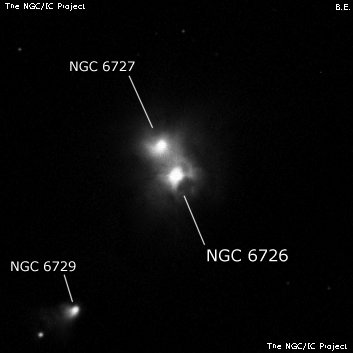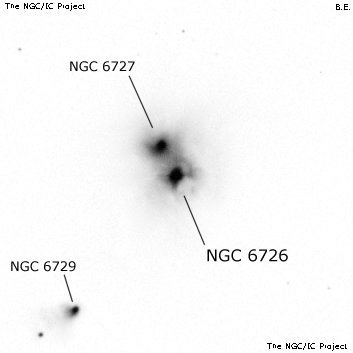NGC/IC Project Restoration Effort
(This is a very very beta version)
NGC6726


Basic Information
Location and Magnitude
Right Ascension: 19:1:39.2
Declination: -36:53:29
Constellation: CRA
Visual Magnitude:
Historic Information
Discoverer: Schmidt
Year of discovery: 1861
Discovery aperture: 6.2
Observational
Summary description: * 6·7 in F, pL, neb
Sub-type: RN
Corwin's Notes
=====
NGC 6726, NGC 6727, and NGC 6729 are all stars immersed in nebulae. Delisle
Stewart found them associated with a much larger and fainter nebulosity, IC
4812 (which see), on a 5-hour Harvard plate. The positions I give apply to
the stars.
Steve's Notes
=====
NGC 6726
18" (7/10/02 - Magellan Observatory, Australia): this is the south-southwest component of two very bright, similar reflection nebulae oriented SSW-NNE and both surrounding bright stars and each 1.5'-2.0' in diameter with a separation of 57" (the two stars form the pair B 957). The nebulae are in contact with overlapping halos forming a figure 8. Also sharing this eerie dark field obscured by dust is the unusual cometary nebula NGC 6729 5' SSE.
17.5" (7/29/92): two bright, round nebulae oriented SSW-NNE: The SSW component (NGC 6726) surrounds a mag 7.2 star and the NNE component (NGC 6727) surrounds the variable star TY Coronae Australis (mag 9.5-10). Both nebulae are roughly 1.5' diameter and in contact with overlapping halos. The evenly matched double star BRS 14 = 6.6/6.8 at 13" is 13' SW. Very unusual dark field is void of stars and set in a striking low power field with nebula NGC 6729 and globular NGC 6723.
8" (7/31/81): two fairly bright, round patches in contact surrounding a wide pair (B 957) consisting of a mag 7.2 star and the variable TY CrA (8.8-12.5) at 58". A closer double star BRS 14 (6.5/7.0 at 13") to the SW. In a stunning low power field with NGC 6729 and gc NGC 6723.



